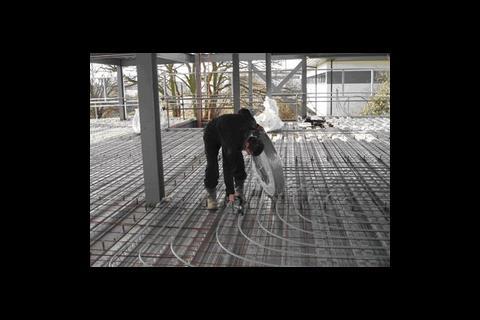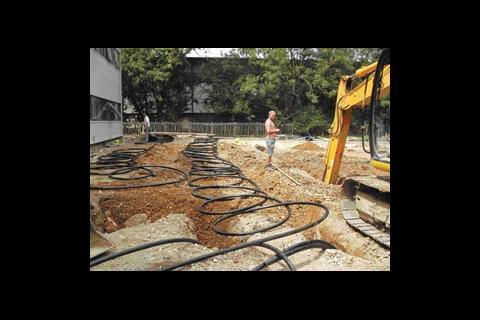… are just some of the technologies employed by Warmafloor for its new head office building
“We’ve put our money where our mouth is,” says Mike Lamb, managing director of underfloor heating and cooling pipework systems manufacturer Warmafloor.
He is talking about the new head office and training centre the firm has constructed on a greenfield site as a low-energy showcase for its underfloor heating and cooling system. The building will also be a test-bed for some newer technologies including a chilled ceiling and a convector unit.
The underfloor heating and cooling pipework was cast into the three-storey building’s concrete floor slabs during construction. Heated or cooled water from a ground source heat pump supplies the underfloor system. The heat pump is connected to 4 km of
50 mm MDP ground loops buried under the car park. Lamb says: “The floors’ thermal mass adds stability to the internal conditions, which works with the underfloor heating and cooling as the active element.”
The office areas and meeting rooms, which will be subject to instant high occupancy loads, have a metal ceiling system that will provide both top-up heating and cooling when required. The ceiling is constructed from a straightforward grid system with Warmafloor's pipework simply clipped to the back of the ceiling panels. Like the underfloor system, the ceilings are heated or cooled using water supplied from the ground source heat pump.
Warmafloor has installed one other piece of technology, which Lamb calls a “convec” unit, in some of the meeting rooms. These are essentially linear, fan-powered convector units specially imported from Denmark. Again, the convec unit is connected to the ground source heat pump circuit. Lamb says the ceiling, floors and convec units are designed to work with each other or as independent sources of heating and cooling.
In addition to the ground source technologies, the new headquarters incorporates a condensing boiler to top up heating in winter, a predominantly natural ventilation strategy using opening windows (although the scheme does incorporate a fresh air supply unit for when conditions become uncomfortable), PIR lighting control for toilets and service areas, solar powered hot water system and rainwater harvesting for use in toilet flushing, vehicle washing and irrigation of the grounds. There is even a connection for a wind turbine.
Lamb estimates the sustainable technologies will reduce the energy consumption of the building by approximately 80% over conventional mechanical services. He claims this will show a saving of up to 8kg of C02/m2 per year. To back up his claims, Lamb has commissioned BSRIA to monitor the building over the coming year – watch this space.
Source
Building Sustainable Design























No comments yet